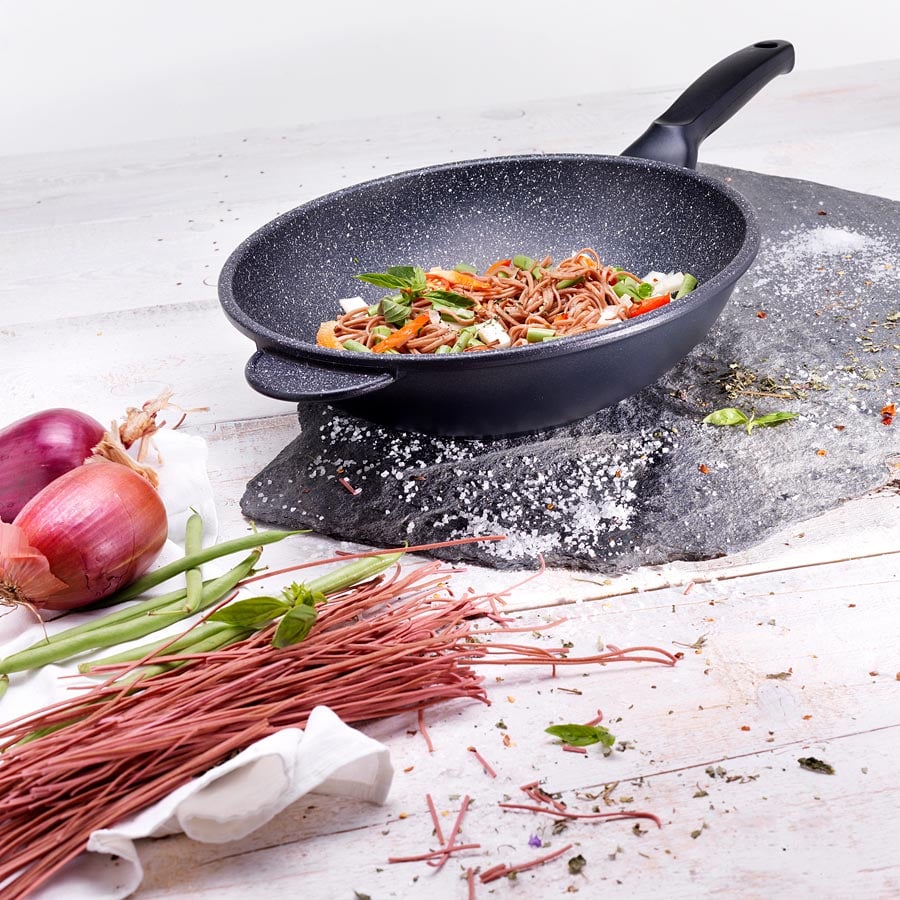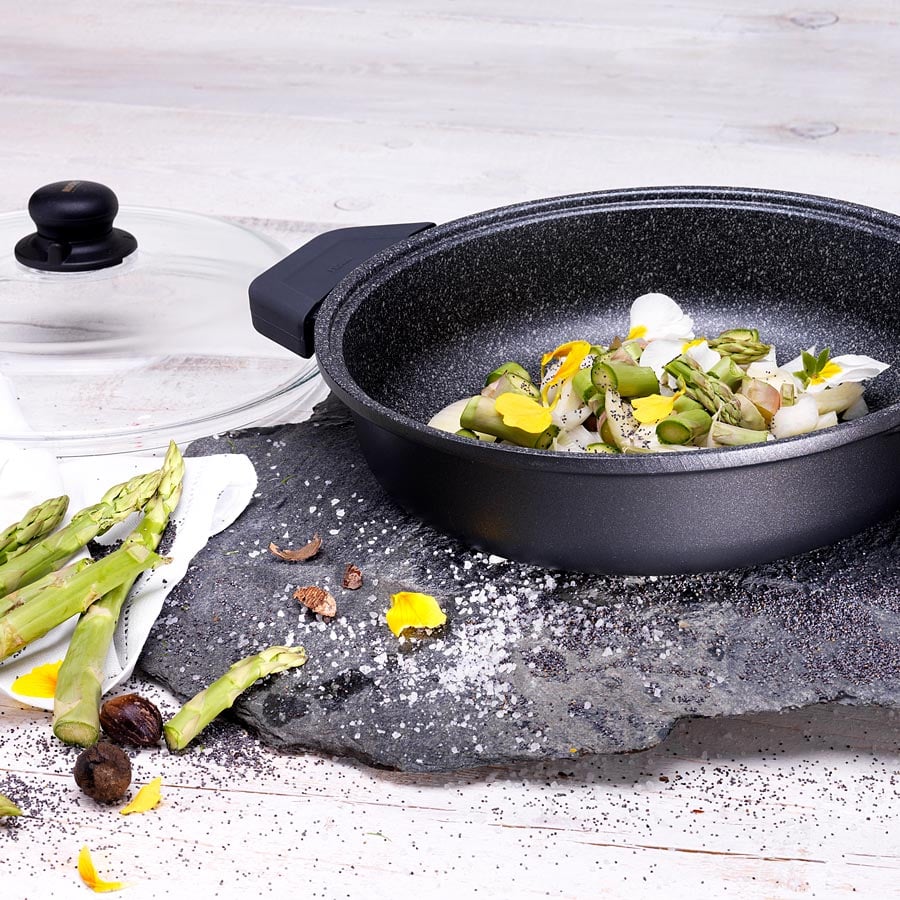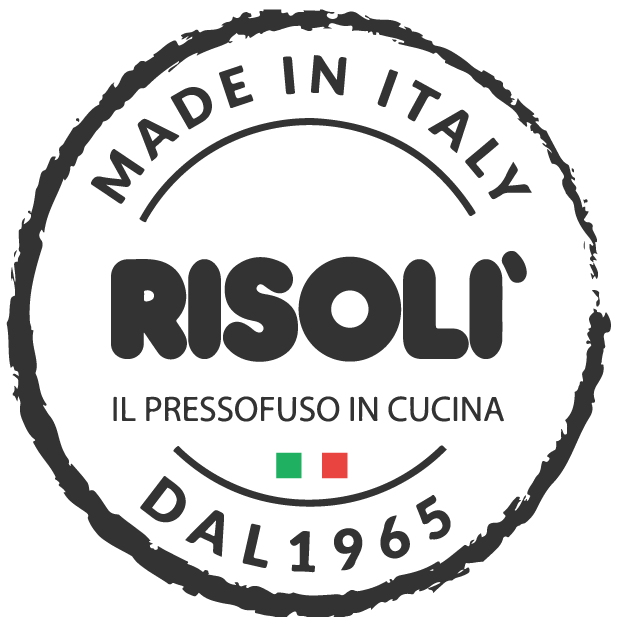Faq & instructions
Frequently asked questions
Is non-stick coating safe?
Yes! The wave of emotion caused by false reports by some media has risked giving non-stick cookware a bad name. This news has no scientific value. To clarify the matter and protect the quality and safety of non-stick products, the leading Italian manufacturers of non-stick cookware have decided to pass the ball to scientists, to obtain a neutral and definitive opinion.
Gas or induction?
The main difference between gas and induction lies in the speed and temperature maintenance. While gas hobs allow more precise heat management, induction hobs heat up much faster and minimise heat transfer errors and energy loss.
The uniformity of heat does not depend on the hob but on the tool you use, which is why pans such as full-bottomed (braze welding HEAT® technology) are extremely useful for getting the best results from your induction hob.
Induction: dotted bottom or solid bottom?
To preserve your induction hob, you need quality cooking utensils that save energy and do not waste heat.
You will often find dotted-bottom pans on the market. Did you know that this type of product derives from a reduction in the materials used during manufacture and does not guarantee quality performance and even cooking?
Risolì induction cookware is equipped with a solid bottom (braze-welded HEAT® technology), which guarantees high performance, allowing you to make the most of your kitchen and create exceptional dishes.
Is PFOA present in non-stick coatings?
No! Some media have confused PFOA with PTFE or Teflon®, the substance that is used to give utensils their non-stick properties. PFOA appears to be absent in non-stick coatings. The EPA itself has never questioned the safety of non-stick utensils, which, on the contrary, can be used with confidence.
Is the safety of PTFE or TEFLON® certified?
Yes! As proof of its chemical inertia and therefore its safety, it should be noted that the fluoropolymer used in non-stick coatings is also used in surgery to coat cardiac stimulators, as well as in thoracic surgery. European regulatory agencies such as the European Food Safety Authority (EFSA), the French Food Safety Agency (AFSSA) and US agencies such as the Food and Drug Administration (FDA) have confirmed that non-stick coatings made from fluoropolymers are safe for their intended use in the kitchen. The Food and Drug Administration (FDA) has reiterated that particles of non-stick material, even if accidentally ingested, do not pose a health risk. Thanks to their chemical inertia they do not undergo any transformation but pass unaltered through the body, like dietary fibre, and are thus harmless to our body.
Does the use of scratched pans pose health risks?
No! Due to its chemical inertness and thus its safety, it is pointed out that the fluoropolymer used in non-stick coatings is also used in surgery to coat pacemakers and also in thoracic surgery. The use of scratched cookware poses no health risk to the consumer but, if anything, the utensil should be replaced simply because it ceases to perform its specific function of being non-stick when a significant part of the coating is missing.
Who carried out the study on the health and environmental safety of non-stick cookware?
The experts who assessed the health and environmental safety of non-stick cookware are:
Prof. FRANCO BATTAGLIA
Professor of Environmental Chemistry University of Modena
Prof. GIANNI FOCHI
Professor of Chemistry Scuola Normale Superiore of Pisa
Are there any rules for the correct use of non-stick coated cooking utensils?
Risolì offers 6 practical tips for the correct use of non-stick coated utensils:
- Before using the pan for the first time, wash it with lukewarm water and dishwashing liquid. Dry it and spread a thin film of oil on the bottom, repeating this every so often.
- Do not cut food inside the utensil. It is advisable not to use sharp metal utensils, preferring to use kitchen utensils made of wood, plastic or silicone. Store the utensil carefully to preserve the non-stick coating.
- Non-stick utensils are easily washed using liquid detergent and a simple sponge. Avoid using abrasive utensils such as scouring pads or wire brushes.
- Never heat the empty pan, use a heat source that matches the size of the bottom of the utensil; centre the utensil on the heat source, a moderate flame is always sufficient. Never char fatty food.
- Let the utensil cool down before cleaning it: temperature changes can deform the bottom.
- When pans are extensively scratched in any case, our advice is to replace them, as they are no longer able to guarantee non-stickness during cooking.
What is meant by 'normal' domestic use?
Pans with non-stick coatings from DuPont can be heated to temperatures of up to 260 °C without damaging the coating. This temperature is far higher than that required for boiling, frying and baking.
For example:
- Water boils at 100 °C.
- Normal temperatures used for browning meat range from 204 °C to 243 °C.
- In the oven, the highest temperatures used for cooking poultry or vegetables are around 232 °C. Cakes and biscuits are usually baked at temperatures between 162 °C and 204 °C.
How to avoid overheating non-stick pans?
It is best to heat non-stick pans at a medium or low temperature. Higher temperatures (above 206 °C) may be reached during cooking, but the food will tend to burn and generate smoke, making it inedible. Even higher temperatures (above 316 °C) can be reached in a few minutes if a dry or empty pan is left on the stove or in the oven. Non-stick pots and pans should never be left on the stove empty and unattended.


Use and maintenance: 10 golden rules
1. First use
When using for the first time, rinse with hot water and liquid detergent and dry thoroughly; then grease the bottom with a little oil or butter.
For best cooking results cook only at MEDIUM OR LOW FLAME. Overheating the product at temperatures above 200-240°C (depending on the line) can damage the non-stick coating. NEVER heat the product empty.
2. Food preservation
The product should only be used for cooking NOT for storing food, as food that is aggressive in the long term can damage the non-stick coating.
3. Utensils
Use ONLY WOODEN or SYNTHETIC utensils for cooking.
4. Ideal cleaning
After use, allow to cool and wipe off with warm water and dry thoroughly.
5. Using the dishwasher
We do not recommend the use of a dishwasher; some aggressive detergents can damage the product. Use Green Clean detergent for longer tool life.
6. Colour variations
Slight colour variations of the inner or outer coating do not alter the functionality of the product.
7. Handles and knobs
Bakelite handles and knobs withstand heat at MAX temperatures of 180-240°C.
8. Use in the oven
Pots and pans without plastic parts are also suitable for the oven.
The use of a protection (pot holders) is necessary to ensure safe handling of the article.
9. Cooking hobs
Risolì products can be used on gas, electric hotplates, glass-ceramic hotplates and ovens; Risolì has a special line suitable ALSO FOR INDUCTION.
10. Warranty
The product warranty (2+1 years) is valid from the date of purchase (by presenting the sales receipt or coupon) and only if the above instructions for use are followed. We will not be held responsible for damages resulting from improper use of the product.
